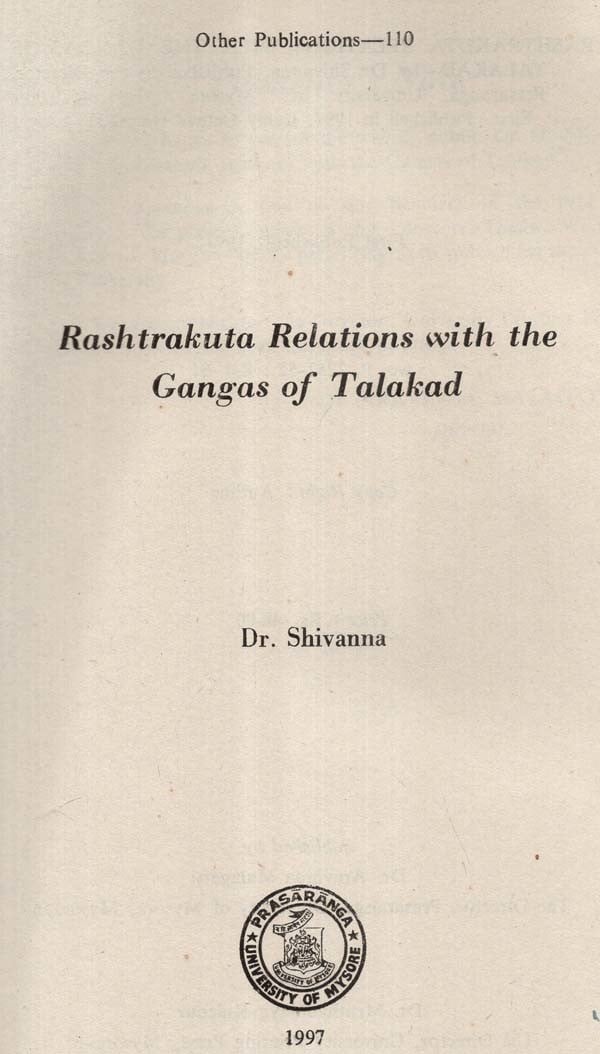About the Book The book Rashtrakuta Relations with the Gangas of Talakad gives a lucid account of the political developments in South India in general and the relations between the Rashtrakuta of Manyakheta and the Gangas of Talakad in particular. It is a study of Interstate relations in early Medieval South India. The emergence of the Rashtrakuta in the Deccan in the middle of eight century A.D. is an important event. They ruled for more than two hundred years and established their hegemony not only in the South but intruded into North India. Their involvement in the politics of the Indo-Gangetic plain has rendered their record as an impressive imperial power. They eclipsed all other contemporary powers and as a result Manyakheta became the pivot of political affairs. It must be stated that until recently Kanauj was considered to be the centre of all political activities by the historians. Almost all the contemporary powers were either overawed or subjugated and among them it was in the Ganga kingdom that the Rashtrakuta interference was felt to the maximum extent from the beginning to the end of the Rashtrakata rule. But no other contemporary power had a taste of enmity as well as friendship with this imperial power as the Gangas. This book is a study into this important aspect of the history of early medieval south India.
Preface It is generally agreed that our national history has been written in some perspective, but the same cannot be said in respect of our regional history. In recent times there are attempts to write regional histories with regional leanings forgetting the national perspective which is not a healthy sign. Aware of this tendency and recognising my own limitations, I have attempted to analyse and explain the Rashtrakuta-Ganga relation not forgetting the national perspective.
It was some 90 years ago that John F. Fleet, who for the first time threw some light on the Rashtrakutas in his work. The Dynasties of the Kanarese Districts" which formed a part of the Bombay Gazetteer. After him many scholars referred to the Rashtrakutas in the general histories, but no genuine efforts were made to write a comprehensive history of the Rashtrakutas covering all aspects of their over 200 years of rule. In the 1930's A. S. Altekar made a sincere attempt to write their history and his monograph, The Rashtrakutas and Their Times" remains to this day the only authoritative book. Since he wrote, plenty of fresh material has come to light and some of the conclusions need revision.
Introduction With the decline of the Gupta power, the political and administrative set up of the country underwent a change. The invasion of the Huns and other frontier tribesmen introduced a new militant element into Indian society and gave rise to what may be called "The New Kshatriyas". The emergence of the new Kshatriyas who are generally called the Rajputs greatly altered the political, military and social life of the country. Centrifugal forces replaced centripetel forces, unity gave place to disunity and the whole country split into small states exercising various degrees of sovereignty (enjoying different degrees of independence). The socio-military organization of the period unleashed the forces of jealousy and rivalry and engaged them in fruitless warfare which was not to cease till the parties were exhausted. The Gurjara Pratiharas, the Palas and the Paramaras tried to dominate the political life of north India. This set up was as true of north India as of the south. The Chalukyas of Badami had held their sway over the Deccan with the active connivance of their allied houses such as the Western Gangas and the Eastern Chalukyas. As their kingdom gained strength, its weight was felt by the Pallavas and a struggle began between them. The main issue in their conflict was the question as to who, the Chalukya or the Pallava, Badami or Kanchi that is supreme in South India. This conflict resulting in reciprocal campaigns on each other's territory, exhausted them both and facilitated the task of their chiefs to take advantage of their weakness. It was this weakness of the Chalukyas that was exploited by the Rashtrakutas to their own advantage.
**Contents and Sample Pages**






















